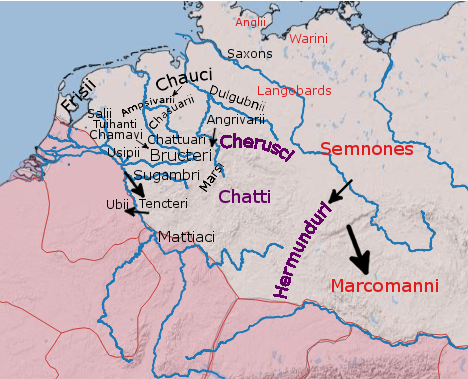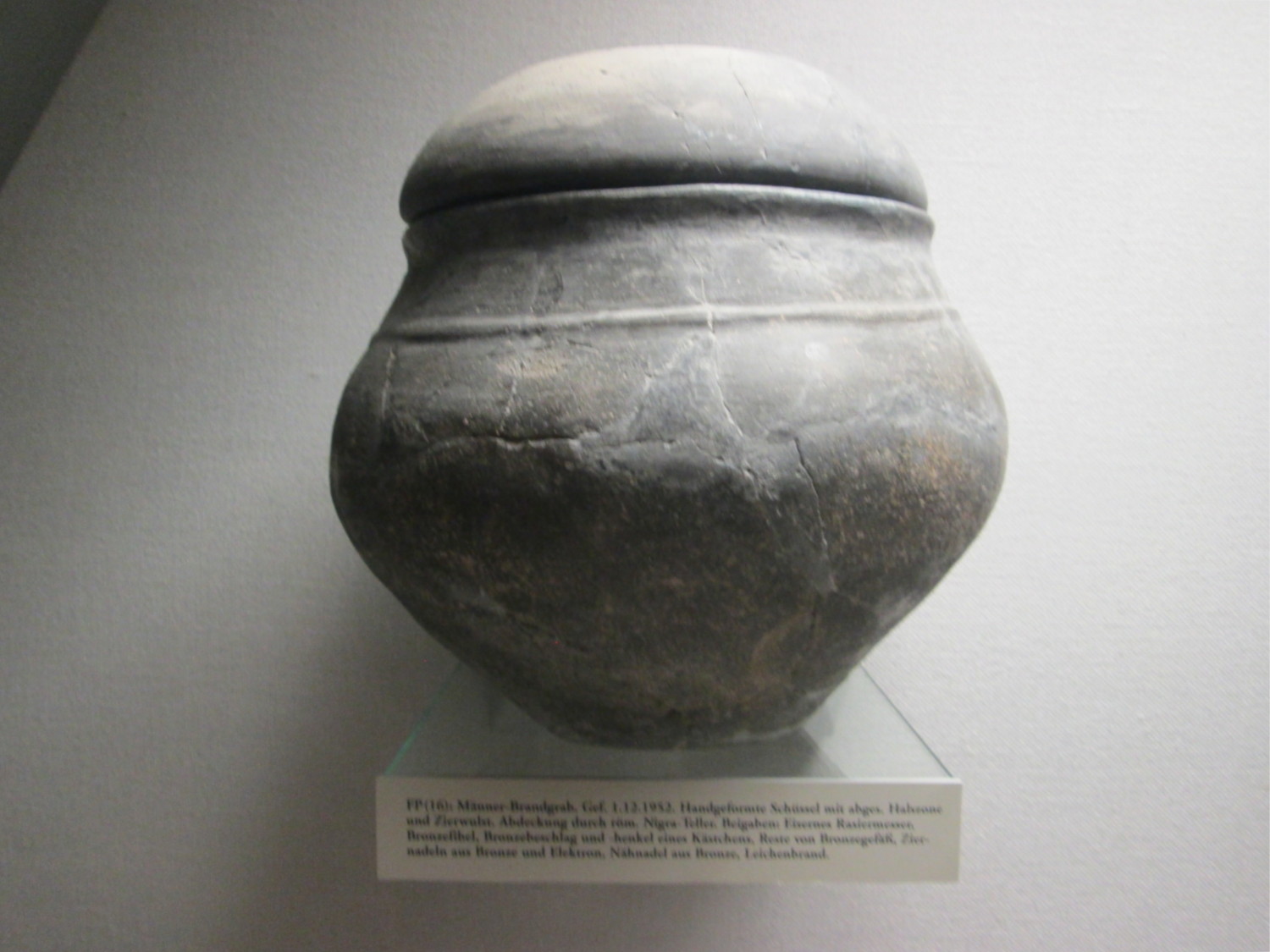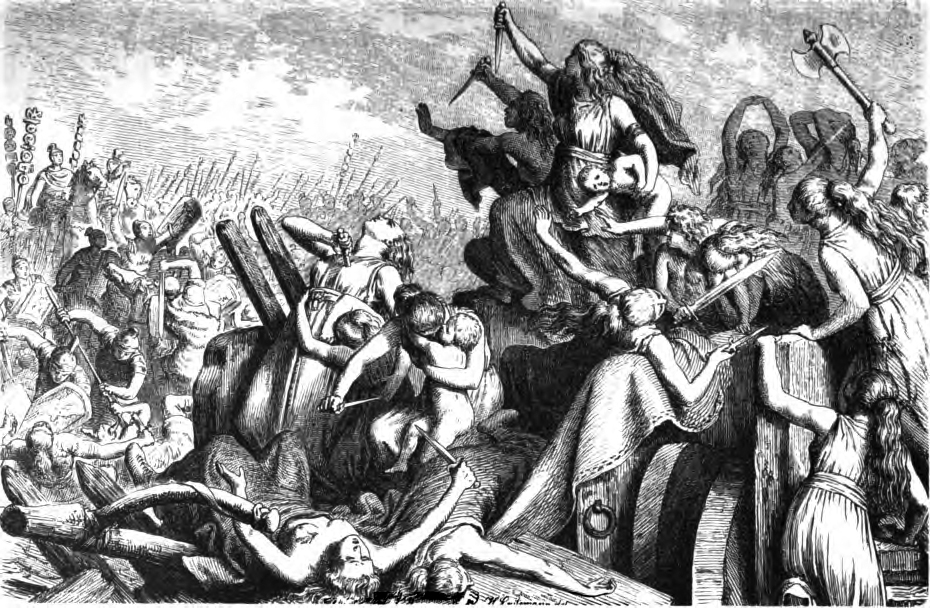|
Irminones
The Irminones, also referred to as Herminones or Hermiones (), were a large group of early Germanic tribes settling in the Elbe watershed and by the first century AD expanding into Bavaria, Swabia, and Bohemia. Notably this included the large sub-group of the Suevi, that itself contained many different tribal groups, but the Irminones also included for example the Chatti. The term Irminonic therefore is also used as a term for Elbe Germanic, which is one of the proposed (but unattested) dialect groups ancestral to the West Germanic languages, West Germanic language family, especially the High German languages, which include modern Standard German. History of use Classical The name Irminones or Hermiones comes from Tacitus's ''Germania (book), Germania'' (AD 98), where he categorized them as one of the tribes that some people say were descended from Mannus, and noted that they lived in the interior of Germania. Other Germanic peoples, Germanic groups of tribes were the Ingaevo ... [...More Info...] [...Related Items...] OR: [Wikipedia] [Google] [Baidu] |
Suevi
file:1st century Germani.png, 300px, The approximate positions of some Germanic peoples reported by Graeco-Roman authors in the 1st century. Suebian peoples in red, and other Irminones in purple. The Suebi (also spelled Suavi, Suevi or Suebians) were a large group of Germanic peoples originally from the Elbe river region in what is now Germany and the Czech Republic. In the early Roman era they included many peoples with their own names such as the Marcomanni, Quadi, Hermunduri, Semnones, and Lombards. New groupings formed later, such as the Alamanni and Bavarians, and two kingdoms in the Migration Period were simply referred to as Suebian. Although Tacitus specified that the Suebian group was not an old tribal group itself, the Suebian peoples are associated by Pliny the Elder with the Irminones, a grouping of Germanic peoples who claimed ancestral connections. Tacitus mentions Suebian languages, and a geographical "Suevia". The Suevians were first mentioned by Julius Caesar i ... [...More Info...] [...Related Items...] OR: [Wikipedia] [Google] [Baidu] |
Elbe Germanic
Elbe Germanic, also called Irminonic or Erminonic, is a proposed subgrouping of West Germanic languages introduced by the German linguist Friedrich Maurer (1898–1984) in his book, ''Nordgermanen und Alemanen'', to describe the West Germanic dialects ancestral to Lombardic, Alemannic, Bavarian and Thuringian. During late antiquity and the Middle Ages, its supposed descendants had a profound influence on the neighboring West Central German dialects and, later, in the form of Standard German, on the German language as a whole. Nomenclature The term ''Irminonic'' is derived from the Irminones, a culturo-linguistic grouping of Germanic tribes that was mentioned by Tacitus in his ''Germania''. Pliny the Elder further specified its meaning by claiming that the Irminones lived "in the interior", meaning not close to the Rhine or North Sea. Maurer used Pliny to refer to the dialects spoken by the Suevi, Bavarii, Alemanni and Lombards around the Hercynian Forest and the Northeas ... [...More Info...] [...Related Items...] OR: [Wikipedia] [Google] [Baidu] |
Ingaevones
The Ingaevones () or Ingvaeones () were a Germanic peoples, Germanic cultural group living in the Northern Germania along the North Sea coast in the areas of Jutland, Holstein, and Lower Saxony in classical antiquity. Tribes in this area included the Angles (tribe), Angles, Chauci, Saxons, and Jutes. The name is transmitted in two different forms in ancient sources: Tacitus provides the form , while Pliny the Elder has . Most scholars derive the name from the god or hero attested under the name Yngvi in later Norse sources, and thus believe Pliny's form is the original one. Hence the postulated common group of closely related dialects of the "Ingvaeones" is called Ingvaeonic or North Sea Germanic. Tacitus' source categorized the ''Ingaevones near the ocean'' as one of the three tribal groups descended from the three sons of Mannus, son of Tuisto, progenitor of all the Germanic peoples, the other two being the ''Irminones'' and the ''Istaevones''. According to the speculations of ... [...More Info...] [...Related Items...] OR: [Wikipedia] [Google] [Baidu] |
Mannus
Mannus, according to the Roman writer Tacitus, was a figure in the creation Germanic mythology, myths of the Germanic tribes. Tacitus is the only source of these myths. This is a university textbook and exists in several variants printed for different major institutions. Reprinted 2007, . Tacitus wrote that Mannus was the son of Tuisto and the progenitor of the three Germanic tribes Ingaevones, Irminones, Herminones and Istvaeones. In discussing the German tribes, Tacitus wrote: Several authors consider the name ''Mannus'' in Tacitus's work to stem from an Proto-Indo-European language, Indo-European root. The Latinized name is evidently of some relation to Proto-Germanic language, Proto-Germanic , 'man'. Mannus again became popular in literature in the 16th century, after works published by Annius de Viterbo and Johannes Aventinus purported to list him as a primeval king over Germany and Sarmatia. In the 19th century, F. Nork wrote that the names of the three sons of Man ... [...More Info...] [...Related Items...] OR: [Wikipedia] [Google] [Baidu] |
Semnones
The Semnones were a Germanic and specifically a Suebi people, located between the Elbe and the Oder in the 1st and 2nd centuries AD. They were described in the late 1st century by Tacitus in his ''Germania'': "The Semnones give themselves out to be the most ancient and renowned branch of the Suebi. Their antiquity is strongly attested by their religion. At a stated period, all the tribes of the same group assemble by their representatives in a grove consecrated by the auguries of their forefathers, and by immemorial associations of terror. Here, having publicly slaughtered a human victim, they celebrate the horrible beginning of their barbarous rite. Reverence also in other ways is paid to the grove. No one enters it except bound with a chain, as an inferior acknowledging the might of the local divinity. If he chance to fall, it is not lawful for him to be lifted up, or to rise to his feet; he must crawl out along the ground. All this superstition implies the belief that from thi ... [...More Info...] [...Related Items...] OR: [Wikipedia] [Google] [Baidu] |
Marcomanni
The Marcomanni were a Germanic people who lived close to the border of the Roman Empire, north of the River Danube, and are mentioned in Roman records from approximately 60 BC until about 400 AD. They were one of the most important members of the powerful cluster of allied Suebian peoples in this region, which also included the Hermunduri, Varisti, and Quadi along the Danube, and the Semnones and Langobardi to their north. After a major defeat to the Romans in about 9 BC, the Marcomanni somehow received a new king named Maroboduus, who had grown up in Rome. He subsequently led his people and several others into a region surrounded by forests and mountains in the present day Czech Republic. Before 9 BC the homeland of the Marcomanni is not known, but archaeological evidence suggests that they lived near the central Elbe river and Saale, or possibly to the southwest of this region in Franconia. The Marcomanni were first reported by Julius Caesar among the Germanic peoples ... [...More Info...] [...Related Items...] OR: [Wikipedia] [Google] [Baidu] |
Germania (book)
The ''Germania'', written by the Roman historian Publius Cornelius Tacitus around 98 AD and originally titled ''On the Origin and Situation of the Germans'' (), is a historical and ethnographic work on the Germanic peoples outside the Roman Empire. Contents The ''Germania'' begins with a description of the lands, laws, and customs of the Germanic people (chapters 1–27); it then describes individual peoples, beginning with those dwelling closest to Roman lands and ending on the uttermost shores of the Baltic, among the amber-gathering Aesti, the Fenni, and the unknown peoples beyond them. Tacitus says (chapter 2) that physically, the Germanic peoples appear to be a distinct nation, not an admixture of their neighbors, since nobody would desire to migrate to a climate as horrid as that of Germania. They are divided into three large branches, the Ingaevones, the Irminones, and the Istaevones, deriving their ancestry from three sons of Mannus, son of Tuisto, their comm ... [...More Info...] [...Related Items...] OR: [Wikipedia] [Google] [Baidu] |
High German Languages
The High German languages (, i.e. ''High German dialects''), or simply High German ( ) – not to be confused with Standard High German which is commonly also called "High German" – comprise the varieties of German spoken south of the Benrath and Uerdingen isoglosses, i.e., in central and southern Germany, Austria, Liechtenstein, Switzerland, Luxembourg, and eastern Belgium, as well as in neighbouring portions of France (Alsace and northern Lorraine), Italy (South Tyrol), the Czech Republic (Bohemia), and Poland ( Upper Silesia). They are also spoken in diasporas in Romania, Russia, Canada, the United States, Brazil, Argentina, Mexico, Chile, and Namibia. High German is marked by the High German consonant shift, separating it from Low German (Low Saxon) and Low Franconian (including Dutch) within the continental West Germanic dialect continuum. "Low" and "high" refer to the lowland and highland geographies typically found in the two areas. Classification As a technica ... [...More Info...] [...Related Items...] OR: [Wikipedia] [Google] [Baidu] |
West Germanic Languages
The West Germanic languages constitute the largest of the three branches of the Germanic languages, Germanic family of languages (the others being the North Germanic languages, North Germanic and the extinct East Germanic languages, East Germanic languages). The West Germanic branch is classically subdivided into three branches: Ingvaeonic, which includes English language, English, the Low German, Low German languages, and the Frisian languages; Istvaeonic, which encompasses Dutch language, Dutch and its close relatives; and Irminonic, which includes German language, German and its close relatives and variants. English is by far the most-spoken West Germanic language, with more than 1 billion speakers worldwide. Within Europe, the three most prevalent West Germanic languages are English, German, and Dutch. Frisian, spoken by about 450,000 people, constitutes a fourth distinct variety of West Germanic. The language family also includes Afrikaans, Yiddish language, Yiddish, Low ... [...More Info...] [...Related Items...] OR: [Wikipedia] [Google] [Baidu] |
Chatti
The Chatti (also Chatthi or Catti) were an ancient Germanic tribe whose homeland was near the upper Weser (''Visurgis'') river. They lived in central and northern Hesse and southern Lower Saxony, along the upper reaches of that river and in the valleys and mountains of the Eder and Fulda regions, a district approximately corresponding to Hesse-Kassel, though probably somewhat more extensive. They settled within the region in the first century BC. According to Tacitus, the Batavians and Cananefates of his time, tribes living within the Roman Empire, were descended from part of the Chatti, who left their homeland after an internal quarrel drove them out, to take up new lands at the mouth of the Rhine. Sources While Julius Caesar (100–44 BC) was well informed about the regions and tribes on the eastern banks of the Rhine, he never mentioned the Chatti by name. In the same large geographical region he clearly named the Suebi as the residents in his time, suggesting th ... [...More Info...] [...Related Items...] OR: [Wikipedia] [Google] [Baidu] |
Teutones
The Teutons (, ; ) were an ancient northern European tribe mentioned by Roman authors. The Teutons are best known for their participation, together with the Cimbri and other groups, in the Cimbrian War with the Roman Republic in the late second century BC. Some generations later, Julius Caesar compared them to the Germanic peoples of his own time, and used this term for all northern peoples located east of the Rhine. Later Roman authors followed his identification. However, there is no direct evidence about whether or not they spoke a Germanic language. Evidence such as the tribal name, and the names of their rulers, as they were written up by Roman historians, indicates a strong influence from Celtic languages. On the other hand, the indications that classical authors gave about the homeland of the Teutones is considered by many scholars to show that they lived in an area associated with early Germanic languages, and not in an area associated with Celtic languages. Name The ... [...More Info...] [...Related Items...] OR: [Wikipedia] [Google] [Baidu] |




